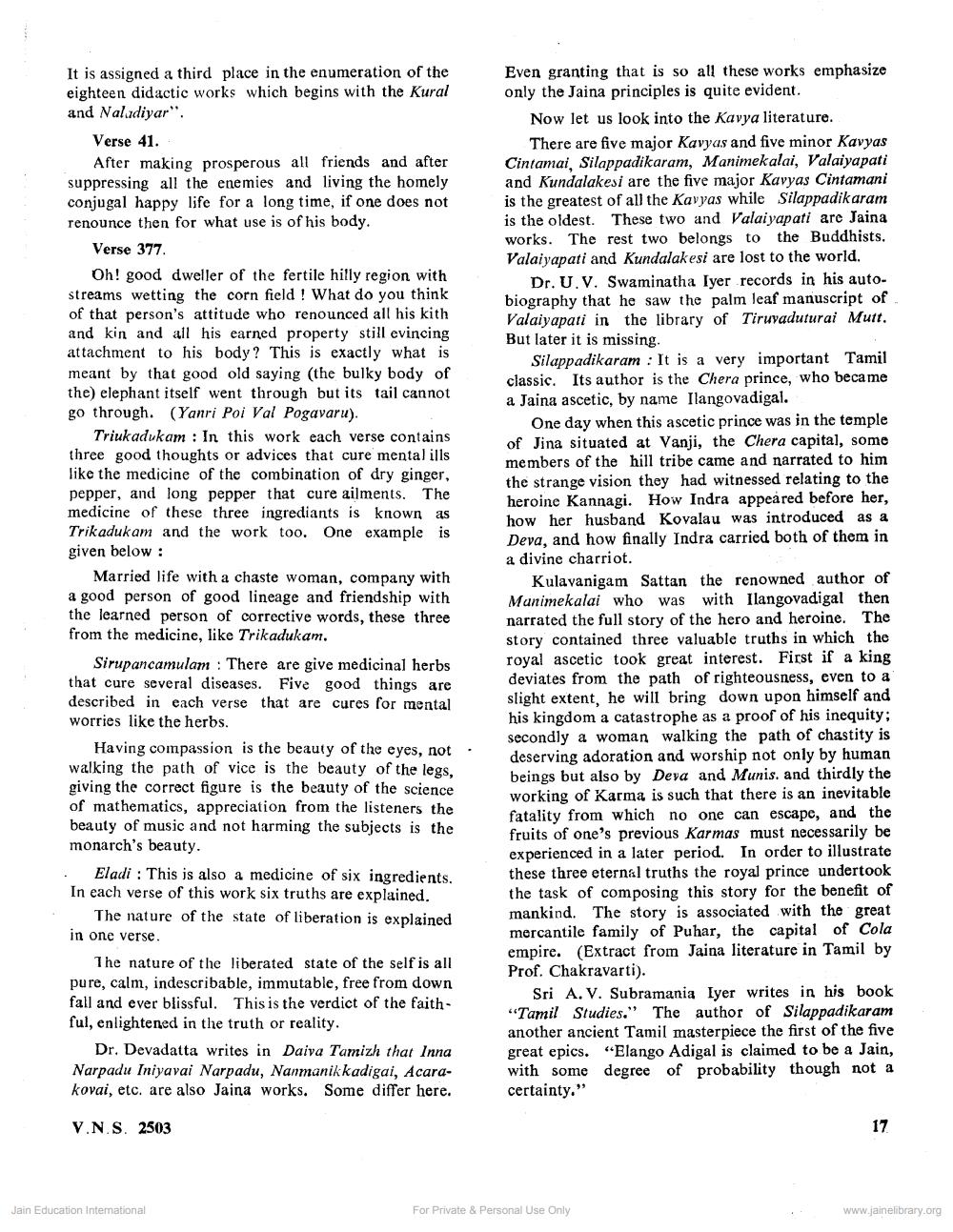Book Title: Jainism in Tamilnadu Author(s): S Gajpathi Publisher: Z_Rajendrasuri_Janma_Sardh_Shatabdi_Granth_012039.pdf View full book textPage 6
________________ It is assigned a third place in the enumeration of the eighteen didactic works which begins with the Kural and Naludiyar". Verse 41. After making prosperous all friends and after suppressing all the enemies and living the homely conjugal happy life for a long time, if one does not renounce then for what use is of his body. Verse 377 Oh! good dweller of the fertile hilly region with streams wetting the corn field! What do you think of that person's attitude who renounced all his kith and kin and all his earned property still evincing attachment to his body? This is exactly what is meant by that good old saying (the bulky body of the) elephant itself went through but its tail cannot go through. (Yanri Poi Val Pogavaru). Triukadukam : In this work each verse contains three good thoughts or advices that cure mental ills like the medicine of the combination of dry ginger, pepper, and long pepper that cure ailments. The medicine of these three ingrediants is known as Trikadukam and the work too. One example is given below : Married life with a chaste woman, company with a good person of good lineage and friendship with the learned person of corrective words, these three from the medicine, like Trikadukam. Even granting that is so all these works emphasize only the Jaina principles is quite evident. Now let us look into the Kavya literature. There are five major Kavyas and five minor Kavyas Cintamai Silappadikaram, Manimekalai, Valaiyapati and Kundalakesi are the five major Kavyas Cintamani is the greatest of all the Kavyas while Silappadikaram is the oldest. These two and Valaiyapati are Jaina works. The rest two belongs to the Buddhists. Valaiyapati and Kundalakesi are lost to the world. Dr. U.V. Swaminatha Iyer records in his autobiography that he saw the palm leaf manuscript of Valaiyapati in the library of Tiruvaduturai Mutt. But later it is missing. Silappadikaram : It is a very important Tamil classic. Its author is the Chera prince, who became a Jaina ascetic, by name Iangovadigal. One day when this ascetic prince was in the temple of Jina situated at Vanji, the Chera capital, some members of the hill tribe came and narrated to him the strange vision they had witnessed relating to the heroine Kannagi. How Indra appeared before her, how her husband Kovalau was introduced as a Deva, and how finally Indra carried both of them in a divine charriot. Kulavanigam Sattan the renowned author of Munimekalai who was with Ilangovadigal then narrated the full story of the hero and heroine. The story contained three valuable truths in which the royal ascetic took great interest. First if a king deviates from the path of righteousness, even to a slight extent, he will bring down upon himself and his kingdom a catastrophe as a proof of his inequity: secondly a woman walking the path of chastity is deserving adoration and worship not only by human beings but also by Deva and Munis, and thirdly the working of Karma is such that there is an inevitable fatality from which no one can escape, and the fruits of one's previous Karmas must necessarily be experienced in a later period. In order to illustrate these three eternal truths the royal prince undertook the task of composing this story for the benefit of mankind. The story is associated with the great mercantile family of Puhar, the capital of Cola empire. (Extract from Jaina literature in Tamil by Prof. Chakravarti). Sri A.V. Subramania Iyer writes in his book "Tamil Studies." The author of Silappadikaram another ancient Tamil masterpiece the first of the five great epics. “Elango Adigal is claimed to be a Jain, with some degree of probability though not a certainty." Sirupancamulam : There are give medicinal herbs that cure several diseases. Five good things are described in each verse that are cures for mental worries like the herbs. Having compassion is the beauty of the eyes, not . walking the path of vice is the beauty of the legs. giving the correct figure is the beauty of the science of mathematics, appreciation from the listeners the beauty of music and not harming the subjects is the monarch's beauty. : Eladi : This is also a medicine of six ingredients. In each verse of this work six truths are explained. The nature of the state of liberation is explained in one verse. The nature of the liberated state of the self is all pure, calm, indescribable, immutable, free from down fall and ever blissful. This is the verdict of the faithful, enlightened in the truth or reality. Dr. Devadatta writes in Daiva Tamizh that Inna Narpadu Iniyavai Narpadu, Nanmanik kadigai, Acarakovai, etc. are also Jaina works. Some differ here. V.N.S. 2503 Jain Education Intemational For Private & Personal Use Only www.jainelibrary.orgPage Navigation
1 ... 4 5 6 7 8 9 10 11 12
